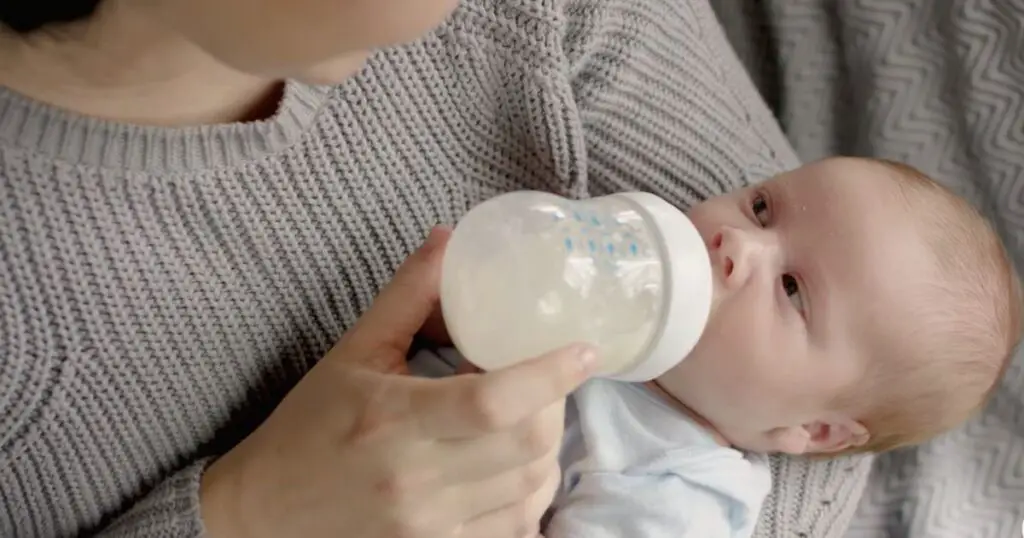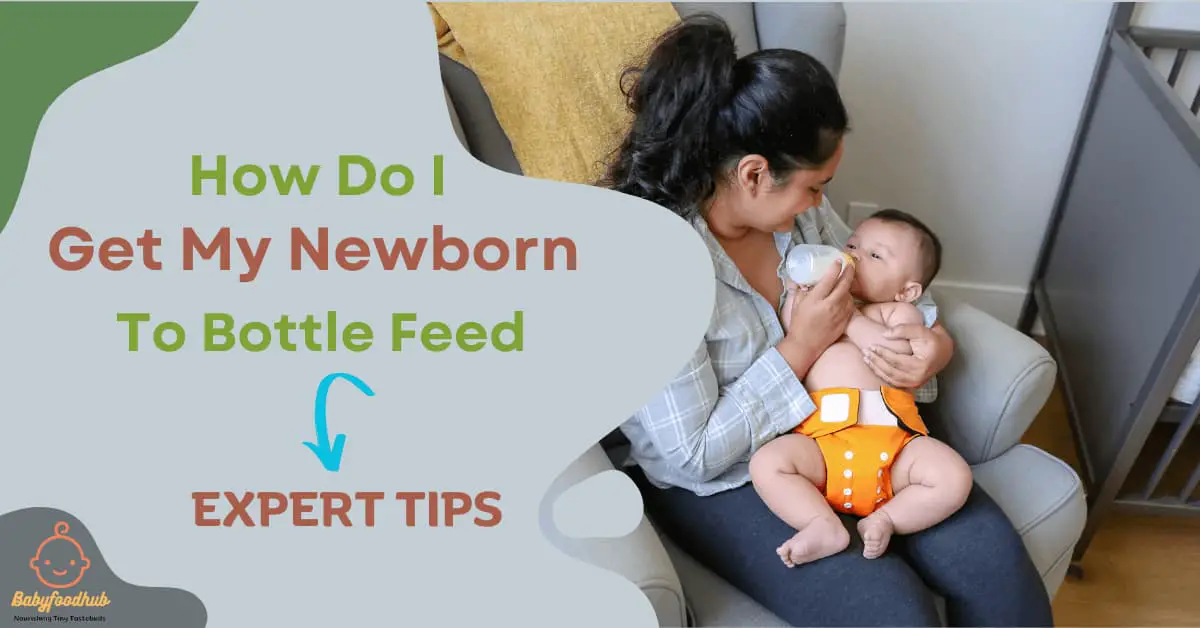How Do I Get My Newborn to Bottle Feed? Seamless Tips
To get your newborn to bottle feed, start by offering a bottle when they are calm and slightly hungry. Use a nipple that mimics the breast to make the transition easier.
When you have a tiny new baby, one of the big things you might worry about is bottle feeding. It sounds simple, but sometimes it can be a bit tricky. Just like learning to ride a bike, getting your newborn to bottle feed can take some patience and practice. Some babies might not want to take the bottle at first, or they might get fussy when you try. This can make parents feel a bit worried or frustrated, but guess what? It’s normal! Most new parents and their little ones face these kinds of challenges.
You see, every baby is different, and so is the way they eat. Some babies might like one type of bottle but not another, or they might need to be held in just the right way to feel comfy and ready to eat. It’s all about figuring out what works best for your baby, which can take a little time. And that’s okay! It’s important to remember that you’re both learning something new together. So, if bottle feeding isn’t going smoothly at first, don’t worry too much. With some love, care, and a few helpful tips, you and your baby will get the hang of it soon!
Understanding The Benefits Of Bottle Feeding
When a newborn enters the family, parents may decide to bottle feed. This choice comes with several advantages. It allows other family members to bond with the baby. It also gives mothers much-needed rest. Plus, it aids families in managing feeding schedules effectively. Let’s delve into the key benefits of bottle-feeding your little one.
Convenience
Bottle feeding offers unmatched convenience, especially for active families. Preparing a bottle is straightforward. You can feed your baby anytime and anywhere. No need to find a private space as you might with breastfeeding.
Flexibility
With bottle feeding, parents gain flexibility in their daily routines. Weaning can happen at a pace that suits the baby and family. Bottles and formula are easy to transport, enabling feeding on the go.
Shared Feeding Responsibilities
Bottle feeding allows other caregivers to share in feeding duties. This shared responsibility means feeding is not solely on one person. It allows parents to take turns at night. Mothers can take breaks, and siblings can experience caring for the new family member.
Preparing For Bottle Feeding
Preparing for bottle feeding can set the stage for a smooth transition from breast to bottle.
Gather Necessary Supplies
Ensuring you have everything needed before starting makes the process easier. Here’s a checklist:
- Bottles – Have various sizes for a growing appetite
- Nipples – Different flows for newborns to infants
- Bottlebrush – For thorough cleaning
- Formula – If not using expressed breast milk
- Burp cloths – For spills and burping your baby
Choose The Right Formula
Selecting a formula can be overwhelming, but the right one will meet your baby’s nutritional needs. Consider:
- Ingredient list – Look for essential nutrients
- Brand reputation – Choose trusted manufacturers
- Pediatrician recommendation – Seek advice from healthcare professionals
Sterilize Bottles And Nipples
Cleanliness is key. Make sure all bottle-feeding equipment is sterile before each use. Follow these steps:
- Wash bottles and nipples with soap and warm water
- Rinse thoroughly to remove all soap residue
- Boil for five minutes or use a sterilizer
Establish A Feeding Routine
A regular feeding routine helps your baby feel secure and satisfied. Stick to these tips:
- Consistent times – Feed at the same times every day
- Quiet environment – Reduce distractions
- Comfortable position – Hold baby in a semi-upright position
- Patient approach – Allow baby to set the pace
Introducing The Bottle To Your Newborn

Transitioning a newborn to bottle feeding can sometimes feel like a task full of uncertainties. Whether you’re a parent planning to return to work or simply wishing to share feeding duties, bottle feeding is a skill that your baby can master with patience and guidance. Let’s explore effective methods to make the experience smooth for both you and your little one.
Timing Is Important
Choose the right moment to introduce the bottle to your baby. The best time is when they are not too hungry or too full. A mid-morning feed might be the ideal opportunity as babies often have a good mood at this time.
Choose A Calm Environment
Select a quiet and comfortable place for the initial bottle feeds. A peaceful setting helps minimize distractions and allows your baby to focus on learning how to bottle feed.
Start With Familiar Breast Milk
Fill the bottle with breast milk your baby already knows. This familiar taste will reassure them and aid them in accepting the new feeding method.
Try Different Nipple Flows
Babies have unique preferences. Offer various nipples with different flow rates to find the one your baby takes best. Begin with a slow-flow nipple to replicate the breastfeeding experience.
Techniques To Encourage Newborns to Bottle Feed

Figuring out how to encourage a newborn to bottle-feed can often be a puzzle for new parents. The right technique can make a world of difference and transform feeding time into a smooth, enjoyable experience. Below are tried-and-true techniques to gently coax your little one into accepting the bottle.
Offer The Bottle When Hungry
Timing is crucial when introducing a bottle. Start by picking a moment when your newborn shows early hunger signs. These signs include lip smacking, sucking on hands, or fussiness. Avoid waiting until your baby is too hungry, as this might lead to frustration and refusal.
Hold The Baby In A Comfortable Position
Comfort is key. Hold your baby in a semi-upright position, supporting their head. This position mimics the natural breastfeeding posture. Use a pillow for extra support if needed. Ensure both you and your baby are comfortable and relaxed before you begin.
Use Gentle And Soothing Motions
Newborns respond well to gentle, calming movements. Softly stroke your baby’s cheek or back as you offer the bottle. These touches are reassuring and can help your baby transition to bottle feeding with less resistance.
Try Responsive Feeding
Keep an eye on your baby’s cues. Responsive feeding means pausing when they want to rest, and continuing when they show more interest. This technique allows your baby to set their own pace, creating a more positive feeding experience.
Dealing With Resistance Or Refusal
Moms and dads sometimes find a baby saying ‘no’ to the bottle. This part of the blog shows ways to change that ‘no’ into a ‘yes’! Feeding with a bottle should be cozy and happy for little ones.
Assess Possible Reasons
It’s like being a detective—figuring out why your baby might be saying no to the bottle. Could it be the milk’s warmth, the bottle type, or just not being hungry? Let’s take a peek at what might be up.
- Check the milk temperature. Babies prefer warm milk, just like how it is when breastfeeding.
- Inspect the bottle and nipple type. Some babies pick favorites. Trying out different ones might click.
- Rule out hunger. If they’re not hungry, they might just play with the bottle instead of eating.
- Consider timing. Offering the bottle when the baby is sleepy might work better.
Offer The Bottle With Patience
Persistence and patience are key. Don’t rush your baby. Give them time to get used to this new way of eating.
Try these steps:
- Start without pressure. Let the baby feel and play with the bottle first.
- Touch the lips gently. It helps to stimulate their natural sucking reflex.
- Wait for cues. When they open up, softly introduce the nipple.
Try Different Feeding Positions
The right hold can make all the difference. Consider these comfy feeding positions:
| Position | Why Try It? |
| Cradle hold | It feels snug and lets you bond eye to eye. |
| Football hold | Great for newborns and moms after a C-section. |
| Elevated head position | Useful if your little one often spits up milk. |
Seek Professional Guidance If Necessary
When tips and patience don’t work, a professional’s help is a good idea. They can spot things we might miss. Here’s when to ring them:
- If the baby seems upset at each feeding time and refuses to eat.
- If there’s less wet diapers. It might mean not enough milk is being drunk.
- If you’re stressed out or unsure about anything, they are there to help.
- They offer advice and can check if the baby has any feeding troubles.
Tips For Successful Bottle Feeding
Tips for successful bottle feeding can make the transition smoother for you and your newborn. It can be a tricky journey, but with patience and the right approach, your baby will take to bottle feeding. Explore these essential tips for a rewarding feeding experience.
Maintain Appropriate Bottle Temperature
Babies prefer milk that’s similar to body temperature. Before feeding, test the milk’s warmth on your wrist to ensure it’s not too hot or cold. A warm, but not hot, bottle can help make mealtime more comforting for your newborn.
Avoid Forceful Feeding
Babies set their own pace, and it’s crucial to follow their lead. Do not rush the feeding process. Offer the bottle, but if your baby resists, give them a moment before trying again. Pressuring a baby to feed can lead to negative associations with the bottle.
Take Breaks If Necessary
Feeding is not just about nutrition, but also bonding. Allow your baby to take pauses. This mimics the natural rhythm of breastfeeding and can aid in digestion. Taking breaks can reduce instances of spit-up or discomfort.
Monitor Feeding Cues
Understanding your baby’s hunger and fullness signals is key. Look for cues like sucking motions, rooting, or hand-to-mouth movements. When they turn away or start playing with the bottle, they might be signaling they’re full.
Transitioning Between Breast And Bottle
Transitioning between breast and bottle can be a gentle journey for both mother and newborn. This nurturing process ensures the baby continues to receive vital nutrition and emotional comfort. Balancing the warmth of a mother’s touch with the convenience of bottle feeding requires patience and technique. Embrace each step with love and understanding, and watch this beautiful transition unfold.
Gradually Decrease Breastfeeding Sessions
Start reducing breastfeeding gradually. This gives your baby time to adjust. Try replacing one breastfeeding session with a bottle every few days. This gentle method eases the shift for your child.
Offer Breast Milk In A Bottle
Introduce breast milk in a bottle first. Use a slow-flow nipple that mimics the breastfeeding experience. This familiar taste in a new format is less daunting for your infant.
Support From a Partner Or Caregiver
Let someone else offer the bottle occasionally. This encourages your baby to accept feeding from others, giving you flexibility. A partner or caregiver holding the bottle helps the baby associate feeding with comfort, not just the mother.
Normalize The Bottle Feeding Experience
- Hold your baby close during bottle feeds. This maintains the comfort and bond of feeding sessions.
- Choose a quiet, calming environment. This minimizes distractions and soothes your baby.
- Stay patient and positive. Babies pick up on emotions, and a positive aura enhances the feeding experience.
Troubleshooting Common Challenges

Welcome to the troubleshooting guide for new parents trying to bottle-feed their newborns. Adjusting to bottle feeding can come with its own set of hurdles. Recognizing and addressing these early can lead to successful and stress-free feeding sessions for both you and your baby.
Gas And Colic
Gas and colic can make bottle feeding a tough time for your little one.
- Use bottles designed to reduce air intake.
- Ensure the bottle’s nipple is always full of milk.
- Hold your baby upright during feedings.
- Take breaks to burp your baby often.
These steps help prevent gas and ease colic symptoms.
Spitting Up
Spitting up is common but can be worrisome.
- Feed your baby in a more upright position.
- Don’t jostle or play vigorously post-feeding.
- Give your baby smaller, more frequent feedings.
This reduces the likelihood of spitting up.
Nipple Confusion
Nipple confusion can arise when alternating between breast and bottle.
- Choose a nipple that mimics the breast in shape and flow.
- Wait to introduce the bottle until breastfeeding is established.
- Have someone else give the bottle to avoid association with breastfeeding.
Patiently introduce the bottle to overcome this confusion.
Overfeeding Or Underfeeding

Understanding your baby’s hunger cues is crucial.
| Signs of Overfeeding | Signs of Underfeeding |
| Gassiness | Constant hunger |
| Frequent spitting up | Restlessness |
| Excess weight gain | Poor weight gain |
Monitor feeding amounts and baby’s growth to balance it right.
Always consult with a pediatrician if you’re concerned about your baby’s feeding and well-being.
Frequently Asked Questions Of How Do I Get My Newborn To Bottle Feed?
How Can I Encourage My Newborn To Bottle Feed?
To encourage your newborn to bottle-feed, offer the bottle when they’re calm, use a slow-flow nipple, and gently stroke their cheek to prompt sucking. Ensure a comfortable position and be patient. Gradually introduce the bottle to establish a routine.
Why Won’t My Newborn Bottle Feed?
Newborns might resist bottle feeding due to nipple confusion, flow preference, discomfort, or illness. Check the nipple size and bottle type, ensure proper positioning, and consult a pediatrician if issues persist.
How Do I Get My Newborn To Take A Bottle?
Start by choosing a quiet time when your newborn is calm. Offer the bottle with your baby slightly upright. Tease their lips with the nipple until they latch on. Keep the bottle at an angle to avoid air ingestion. Be patient and try different bottle nipples if necessary.
What Is The Solution To Baby Refusing Bottle?
Try offering the bottle when the baby is calm, vary the feeding positions, and ensure the milk is at a comfortable temperature. Experiment with different nipple shapes and consistently offer the bottle to establish a routine. Consult a pediatrician if the issue persists.
Conclusion
Mastering the art of bottle-feeding your newborn takes patience and practice. Remember, every baby is unique, so what works for one might differ for another. Keep experimenting with different bottles and feeding positions, and trust your instincts as a parent.
Your bond will grow stronger with each feeding session. Stay persistent, and soon enough, bottle-feeding will become a smooth, joyful experience for both you and your bundle of joy.







